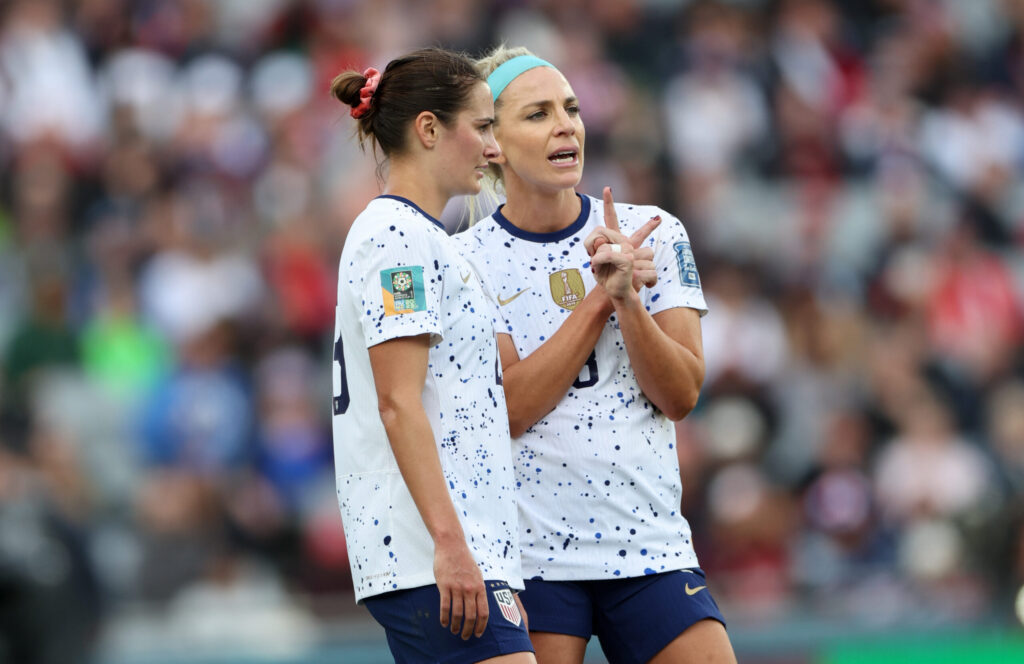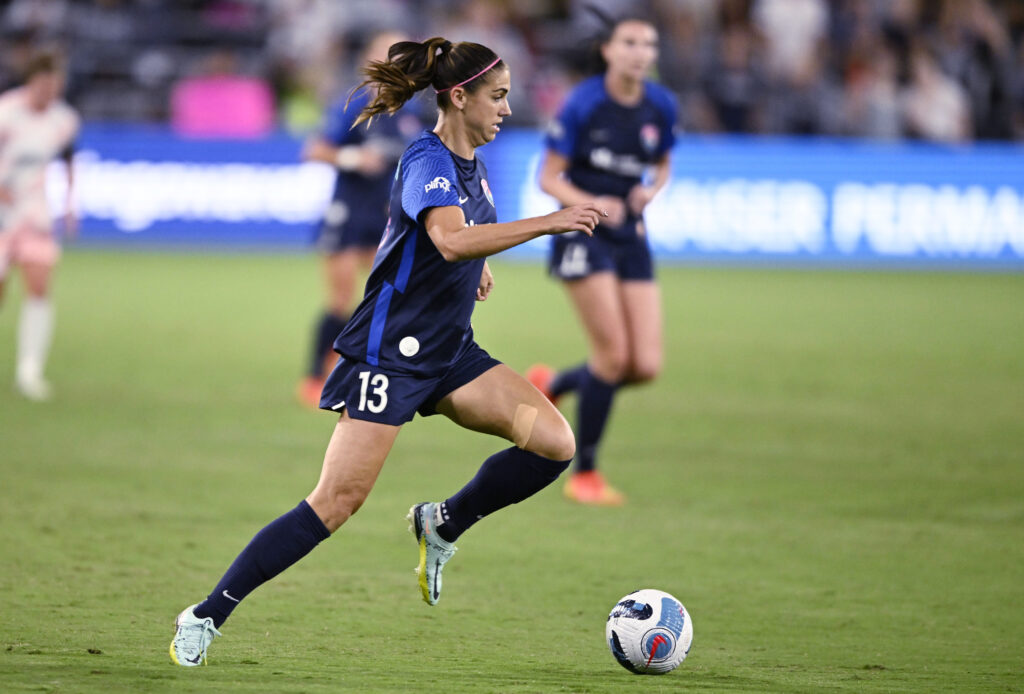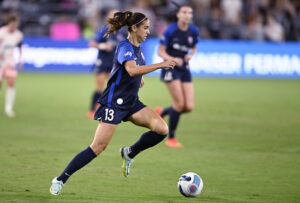If the old adage goes that defense wins championships, U.S. women’s national team head coach Vlatko Andonovski might be taking his faith in the statement a little too far.
The U.S. has given up only one goal so far in the 2023 World Cup, on a single shot on goal. But they’ve also looked disjointed in possession and frantic in the attack en route to a second-place finish in their group.
Despite the legacy of the USWNT’s “Department of Defense,” fans weren’t expecting a defensive lockdown of this magnitude going into the World Cup. As different players with varying strengths rotated in and out of the backline in the lead-up to the tournament, the odd mistake in the defense became a regular occurrence and, to Andonovski, a risk worth taking.
There was a feeling that the team was willing to live or die by their defensive mistakes in the pursuit of strengthening the attack. But what Andonovski has actually prioritized under the glare of the spotlight is shoring up the team’s backline issues at the steep cost of freedom in front of the defense.
A hyper-conservative game plan to limit shots on goal is both a problem the U.S. is having trouble solving and their current lifeline. It doesn’t appear to be a mistake as much as an intentional gamble. But it’s a gamble the USWNT players are not accustomed to executing, even under Andonovski’s management.
The loss of reliable contributors
Injuries to USWNT forwards have rightly gotten a fair amount of attention, but the team’s group stage suggests that Andonovski’s current approach is a way to offset absences in the defense.
What the U.S. defense is missing, as compared to 2019 or even 2021, is the result of incremental loss. While Abby Dahlkemper wasn’t available for selection due to her ongoing recovery from back surgery, other players have been in and out of match fitness. Tierna Davidson returned from her ACL injury in 2023, but was unable to claim her spot as the heir apparent to a USWNT center-back role. Captain Becky Sauerbrunn played sporadically to begin the 2023 NWSL season, and the variable nature of her recovery kept her off the roster entirely.
Other members of the defense are clearly important to team chemistry but cannot get on the field consistently. Kelley O’Hara’s influence on the USWNT is clear, with her leading the huddle after the team’s disappointing draw with Portugal to close out the group stage. But her return to soccer fitness has not been linear in 2023 — before departing for the World Cup, she even played in an attacking role for Gotham FC because she was not getting minutes on their backline.
So Dahlkemper, Davidson and Sauerbrunn are not in camp, and O’Hara’s role is tied more to off-field contributions. O’Hara and Sauerbrunn’s limitations are a consequence of the passing of time and the USWNT’s inability to develop heirs to match their skill sets. Dahlkemper and Davidson’s absences are the result of the twists of fate that saw other notable teammates miss out on a World Cup opportunity.
A lack of confidence in new faces
Two players who rounded out the top five in minutes played for the USWNT in 2022 were center-back Alana Cook and outside-back Sofia Huerta. Both made the 2023 World Cup roster but have yet to make an impact on the field: Huerta played seven minutes against Vietnam, and Cook hasn’t seen the field at all.
Based on their 2022 contributions, their very limited roles at the World Cup might surprise, but the writing has quietly been on the wall in recent months. At the end of 2022, Andonovski began pairing Naomi Girma and Sauerbrunn together consistently, after previously rotating them at left center-back and giving Cook heavy minutes on the right.
The sample size was small enough to register as experimentation, but it could now be read as a coach sensing that Cook’s reaction times in key moments weren’t going to be reliable enough against top competition. In Sauerbrunn’s absence, Andonovski has now seemingly replaced Cook with Julie Ertz, making a conscious decision to prioritize the defense over the midfield and trusting the two-time World Cup champion in partnership with Girma.
Huerta is on the team as a crossing specialist, a player who makes up in attacking generation what she gives up in 1v1 defending. Signs in the early stages of the tournament are that Andonovski feels more comfortable with Emily Fox out of position on the right side of the field than getting Huerta settled in games that make sense for her abilities. Emily Sonnett also appears to be a player Andonovski brought to see games out in their final stages, and not as a reliable starter.

The benefit of a conservative approach
There have been clear positives to the way the U.S. has locked down its defensive roles. The USWNT has given up just the one goal, their xG against ranks fourth among the entire World Cup field, and goalkeeper Alyssa Naeher has not had to register a single save so far in the tournament.
That last point is probably a statistic Andonovski has taken very seriously, based on Naeher’s struggles with the Chicago Red Stars this season. The USWNT goalkeeper player pool is more wide open than ever, but the best-performing American keepers statistically (outside of third keeper Aubrey Kingsbury) are not with the team right now. Again, experience and leadership have taken priority over clearing the way for a brand-new goalkeeping core based on current shot-stopping ability.
Naeher is the player Andonovski wants organizing his defense, and she has progressed year after year with distribution with the ball at her feet. But the USWNT’s hopes for clean sheets seem to rely on her seeing as few shots on goal as possible, which the team so far has been achieving (the one shot on target they did face, against the Netherlands, went in for a goal).
Ertz actually recorded the most impressive save of the group stage, putting in a crucial block against the Netherlands that saved a point for the team and a place in the knockout rounds.
The overwhelming cost of limited freedom
The cost of Andonovski’s approach appears to be everything else that’s recognizable about the USWNT right now. They’ve ceded control of the midfield almost by design, with a resignation that Ertz will control tempo from a deep-lying position. It’s taken further control away from Andi Sullivan, who has lacked reliable passing outlets when she has the ball and struggled to execute a defensive press without it.
With the understanding that the midfield is not intended to hold the ball, Andonovski’s creative players have been tasked with melting into the attack. At times against Portugal, the U.S. lined up with four or five players on their opponent’s backline, waiting for deep-lying players to provide long-ball service without the creative runs necessary to create space.
Andonovski has also settled on playing both of his outside-backs out of position, which has appeared to limit Crystal Dunn and Emily Fox in their movement. Dunn, of course, is a creative midfielder for the Portland Thorns, and Fox plays most freely on the left for the North Carolina Courage. Both players have been mindful of their defensive assignments to a fault in the group stage, sitting back against Vietnam and staying wide rather than filling empty midfield spaces against the Netherlands and Portugal.
Tactics have also taken a toll on the USWNT’s vaunted mentality. As players process their positional assignments in real time, those split-second moments of doubt have disrupted the team’s defensive press and ball progression. Rather than being empowered to play to the team’s strengths, players seem preoccupied with the weaknesses. Those weaknesses are also on display in the team’s substitution patterns, with Andonovski lacking trust in those he brought with him and leaving the team’s depth unused.
Andonovski’s transformation of the U.S. into a team that grinds out results based on conservative tactics is both an indictment of his management of the team over the last four years, and an objective assessment of the team he has constructed. If the U.S. bows out in the Round of 16, he’ll have to answer for both his preparation and his approach.
Claire Watkins is a Staff Writer at Just Women’s Sports. Follow her on Twitter @ScoutRipley.









